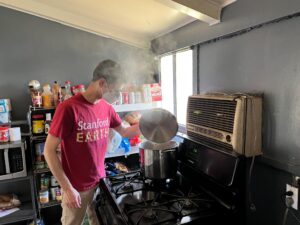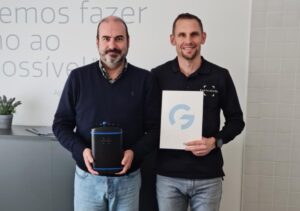Feature: Designing molecular traps to capture indoor air pollutants
Dr Ming Liu, a research associate at the University of Liverpool explains how a new molecular trap for pollutants could revolutionise our approach to indoor air quality.
Indoor air pollutants are generally ‘silent killers’ because they are invisible, odourless and tend to be at very low concentration levels within our homes, schools, and offices.
The most common types are particulate matter, made up of microscopic particles of dust and dirt, and molecular pollutants like volatile organic compounds (VOCs), formaldehyde, carbon monoxide, nitrogen oxides and sulphur dioxide.
Sources such as building materials, furnishings, and products like air fresheners, continuously release a variety of pollutants into the air we breathe. Other sources, related to activities like smoking, cleaning, cooking and decorating release pollutants intermittently.
The World Health Organization estimates indoor air pollution causes 3.8 million premature deaths each year, linked to health conditions such as pneumonia, chronic obstructive pulmonary disease (COPD), stroke, heart disease and lung cancer.
Reports and studies indicate that children, the elderly, and low-income and minority populations may be disproportionately affected by indoor air pollution.
A 2019 report on indoor air pollution found that nearly half of UK homes surveyed had high indoor pollution levels, with high levels of formaldehyde and VOCs.
Formaldehyde is carcinogenic, as well as irritating to the skin, eyes and nose. Sources of formaldehyde are furniture made with pressed wood products such as plywood, particleboard or MDF, the burning of fuels such as natural gas, automobile exhaust, tobacco smoke, and some synthetic fabrics, foams, wallpaper, and paints.

VOCs are a group of chemicals that are linked to nausea, fatigue and headaches and sources are products like paints, varnishes, as well as some cleaning products, personal care products, air fresheners, and scented candles. The same report found awareness of the sources of indoor air pollution were incredibly low.
Air filters in your central heating, ventilation, and air-conditioning system or portable air purifiers can help improve indoor air quality.
Gaseous pollutants can be removed using nanoporous materials, which are often found in air purification systems, which contain pores that absorb pollutants. Although a single pore of the material seems unimaginably tiny, nanoporous materials contain millions of these pores which absorb a counterintuitively high amount of gas, like a sponge.
Activated carbon is the most common adsorbent material used in portable air purifiers and HVAC systems to remove gaseous pollutants. A single gram can have the same surface area as ten tennis courts. Activated carbon can be effective at removing odours, but is not effective against smaller pollutants such as formaldehyde. It can only capture a small amount, which is released back into the air under hot and humid conditions.
Molecular trap for pollutants
In 2009, a new nanoporous material – the porous organic cage – was discovered in our research group, led by Professor Andy Cooper at the University of Liverpool.
As the name implies, these molecules resemble a cage with a double pyramid shape which forms a cavity.
Functional molecules, such as methyl groups, can be added to alter the structure of the cage. Some of these additions change the size and shape of the cavity to fit chemically inert gas molecules, whereas others create binding sites to make the cages ‘stickier’ for more reactive molecules.
Molecules enter the cages and stick to the inner surfaces, becoming trapped. The unique chemistry of each cage determines which molecule it will capture.
To solve the formaldehyde problem, we have developed a cage that can efficiently capture and trap formaldehyde like a molecular prison. Each cage captures nine formaldehyde molecules, which is 500 times more than the same mass of activated charcoal. More importantly, the cages are designed to toxic formaldehyde molecules permanently, preventing them from escaping with rising temperature or humidity.
Beyond formaldehyde
Radon is another indoor air pollutant that poses a significant threat to our health.
Seeping from the ground into homes and workplaces, radon is the single biggest source of radiation exposure to the UK population and is the number one cause of lung cancer among non-smokers.
It is estimated that 14% of the global lung cancer deaths result from exposure to indoor radon with the ratio much higher in children. Active sump systems are currently the most effective method to reduce indoor radon levels, but installation is nontrivial and costly.
In 2014, we developed another cage material that can efficiently capture radon with remarkable selectivity (5,000 over nitrogen).
Our cage material can be used in existing sump systems to improve the efficiency and the safety of the sump system, or fitted into domestic air purifiers to remove indoor air pollutants including radon via air circulation.
Another harmful pollutant is sulphur dioxide (SO2), which is emitted from the burning of solid fuel. Our recent work discovered a new cage material that can capture a remarkably high amount of SO2. Coupled with good processibility options and proven synthetic scalability, we believe that the cage material provides a more sustainable way to capture SO2, compared with traditional alkaline scrubbers which are toxic and corrosive.
Looking ahead
One of the complexities of the indoor air pollution problem is the number of pollutants to address.
The examples we have presented are only the tip of the iceberg. For example, the UK’s Clean Air Strategy 2019 lists Non-Methane Volatile Organic Compounds (NMVOCs) as a principle form of indoor air pollution, which accounts for hundreds of different unique molecules. Conventional material discovery methods are not viable when addressing the magnitude of targets required to solve the indoor air pollution problem.
In the past few years, we have started to use computational tools to design and screen material candidates in the Materials Innovation Factory at the University of Liverpool.
Machine learning and AI-based approaches, along with smart robotics systems have been trialled for the discovery of new functional materials. These computational tools will have a strong place in helping us develop advanced materials to address some of the most pressing indoor air pollution problems.
To learn more, visit: https://cagecapture.com/
















